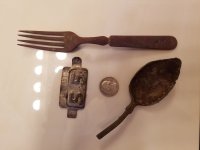RatherBeDigging
Sr. Member
- Jun 16, 2020
- 474
- 2,569
- 🥇 Banner finds
- 3
- Detector(s) used
- Started with a Minelab xterra 505. Then Equinox 600 with stock coil, xl coil and sinper coil depending on circumstances. Now use a manticore.
- Primary Interest:
- Metal Detecting
The U.S. marked fork is made by Sil Co. By 1945 military changed to corrosion resistant steel. This is either tin plated or silver plated. Not much plating left. Washington quarter came from same field as the fork. License plate registration tag is from my grandfather's yard.
The pewter spoon bowl is from a new spot in a rocky creek behind a 1770s mill. Am I correct to call it fiddle back? Definitely pewter. Any idea in age?
The pewter spoon bowl is from a new spot in a rocky creek behind a 1770s mill. Am I correct to call it fiddle back? Definitely pewter. Any idea in age?
Attachments
Upvote
5






